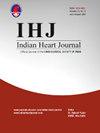印度年轻急性冠状动脉综合征患者冠状动脉斑块的形态特征:一项多中心研究
IF 1.4
Q3 CARDIAC & CARDIOVASCULAR SYSTEMS
引用次数: 0
摘要
目的:动脉粥样硬化和急性冠状动脉综合征(ACS)在印度年轻人(18-50 岁)中的发病率越来越高。然而,人们对这类人群动脉粥样硬化斑块的特征知之甚少,这给急性冠状动脉综合征的治疗带来了独特的挑战。本研究旨在利用光学相干断层扫描(OCT)成像技术分析接受经皮冠状动脉介入治疗(PCI)的印度年轻 ACS 患者的斑块特征:这是一项前瞻性、多中心、非介入性研究,研究对象为18-50岁的ST段抬高型心肌梗死(STEMI)、非ST段抬高型心肌梗死或不稳定型心绞痛患者,并计划在OCT引导下接受PCI治疗。术后及6个月和12个月随访时对主要心脏不良事件(MACE)进行评估:研究纳入了100名ACS患者(平均年龄=43.6±5.2岁),其中51%为STEMI患者。PCI前的OCT评估显示,纤维斑块(75%)最常见,其次是含有巨噬细胞的斑块(27%)、微通道(20%)和钙化结节(14%)。此外,分别有31%、25%、24%、21%、14%和17%的患者(血栓总发生率=52%)观察到斑块破裂、斑块侵蚀和富脂斑块,以及红色、白色和混合血栓。12个月后,MACE冠状动脉搭桥术(CABG)发生率为1%:通过PCI前OCT检查,印度年轻的ACS患者显示出一系列斑块形态。其中,纤维斑块是最突出的类型,其次是含有巨噬细胞的斑块。此外,在该人群中还观察到斑块破裂、斑块侵蚀和富脂斑块。本文章由计算机程序翻译,如有差异,请以英文原文为准。
Morphological characterization of coronary plaques in young indian patients with acute coronary syndrome: A multicentric study
Objectives
The prevalence of atherosclerosis and acute coronary syndrome (ACS) is increasing in young Indians (18–50 years of age). However, the characteristics of atherosclerotic plaques in such individuals are poorly understood, presenting distinct challenges for the management of ACS. This study aims to analyze plaque characteristics in young Indian patients with ACS who underwent percutaneous coronary intervention (PCI) using optical coherence tomography (OCT) imaging.
Methods
This was a prospective, multicentric, non-interventional study on patients aged 18–50 years presenting with ST-elevation myocardial infarction (STEMI), non-ST elevation myocardial infarction, or unstable angina, and were scheduled to undergo OCT-guided PCI. Major adverse cardiac events (MACE) were assessed post-procedure and at the 6-month and 12-month follow-ups.
Results
The study included 100 ACS patients (mean age = 43.6 ± 5.2 years), with 51% presenting with STEMI. Pre-PCI OCT assessment showed that fibrous plaques (75%) were most common followed by plaques containing macrophages (27%), microchannels (20%), and calcified nodules (14%). In addition, plaque rupture, plaque erosion, and lipid-rich plaques, along with red, white, and mixed thrombi, were observed in 31%, 25%, 24%, 21%, 14%, and 17% (total thrombus occurrence = 52%) of the patients, respectively. At 12 months, the MACE (coronary artery bypass graft) rate was 1%.
Conclusions
Young Indian patients with ACS displayed a range of plaque morphologies identified through pre-PCI OCT. Among these, fibrous plaques were the most prominent type, followed by plaques containing macrophages. Additionally, plaque rupture, plaque erosion, and lipid-rich plaques were also observed in this population.
求助全文
通过发布文献求助,成功后即可免费获取论文全文。
去求助
来源期刊

Indian heart journal
CARDIAC & CARDIOVASCULAR SYSTEMS-
CiteScore
2.60
自引率
6.70%
发文量
82
审稿时长
52 days
期刊介绍:
Indian Heart Journal (IHJ) is the official peer-reviewed open access journal of Cardiological Society of India and accepts articles for publication from across the globe. The journal aims to promote high quality research and serve as a platform for dissemination of scientific information in cardiology with particular focus on South Asia. The journal aims to publish cutting edge research in the field of clinical as well as non-clinical cardiology - including cardiovascular medicine and surgery. Some of the topics covered are Heart Failure, Coronary Artery Disease, Hypertension, Interventional Cardiology, Cardiac Surgery, Valvular Heart Disease, Pulmonary Hypertension and Infective Endocarditis. IHJ open access invites original research articles, research briefs, perspective, case reports, case vignette, cardiovascular images, cardiovascular graphics, research letters, correspondence, reader forum, and interesting photographs, for publication. IHJ open access also publishes theme-based special issues and abstracts of papers presented at the annual conference of the Cardiological Society of India.
 求助内容:
求助内容: 应助结果提醒方式:
应助结果提醒方式:


